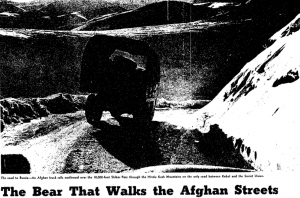
A Soviet supply truck entering Afghanistan in March of 1956.
On March 11, 1956, the Soviet Union and the government of Afghanistan struck an economic agreement that would modernize and industrialize Afghan society. The funds were not limited to military development. Rather, all aspects of Afghan economy and daily life were affected by Soviet involvement. Notable members involved in the deal were Nikita Khrushchev, leader of the Soviet Union, his Premier, Nikolai Bulganin, and Mohammed Daoud, Prime Minister of Afghanistan, with the deal being finalized in Kabul, the capital of Afghanistan.
In the early to mid 1950s, the United States had immense economic interest in the resources found in the Middle East, notably its oil reserves. In addition to energy concerns, the Afghan government after World War II had requisitioned the United States to help modernize its society. Moreover, securing Afghanistan as a Western ally would benefit the United States’ greater Cold War strategy of containment due to it being a border state to the Soviet Union, limiting access to the Middle East. Specifically, the United States’s commitment to containment of Soviet influence and communism was demonstrated in the 1947 Truman Doctrine, delivered by President Harry Truman to Congress. Dwight D. Eisenhower, president at the time of the agreement in 1956, held a far more aggressive stance in foreign policy. Outlined in NSC 162/2, “massive retaliation” was the governing concept of United States foreign policy. This was paired with the policy of rollback, which was the goal of pushing Communism backwards rather than simply containing it. Consequently, a resource-rich area like the Middle East was crucial to the United States to achieve its goals of containment, at the bare minimum, and deterrence. It was equally important to the Soviet Union to protect its national security and ideological interests. Afghanistan’s, and largely Daoud’s, neutralist stance was of great worry to the United States as it could not remove itself from the perception of all relationships being ideological, and the Eisenhower administration held a zero-tolerance policy towards it. Moreover, only two days prior to the ratification of this pact, on March 9, 1956, the New York Times released an article detailing the chief concerns and topics of a SEATO, or Southeast Asia Treaty Organization, meeting where a consistent topic was Soviet subversion within that geographic region. One such concern was economic and political coercion, which was seen to fruition by the Soviet Union in Afghanistan only a couple days later. Furthermore, there were significant ethnic complexities in Afghanistan. The Pushtun peoples wanted to create the state of Pushtunistan, which would have overlapped with Afghanistan and Pakistan. Afghanistan supported the creation of Pushtunistan, while the United States backed Pakistan, which opposed the annexation of part of its territory.
On March 11, 1956, when the partnership between the Soviet Union and Afghanistan was affirmed, The New York Times published an article titled “The Bear that Walks the Afghan Streets,” written by Peggy Streit. This outlined the context, importance, and impact of Soviet influence entering the Middle East. Streit was critical of the United States’ strategy of supporting Afghanistan prior to the event, as most U.S. loans to Afghanistan went towards upper-echelon projects, rather than to the average Afghan. Conversely, the U.S.S.R. focused its aid on “construction of oil storage depots, grain silos, a pipeline from the U.S.S.R. to northern Afghanistan and the paving of streets in Kabul.” Streit further noted how the Soviets chose immediate and readily-visible loans. Yet, the piece itself was not overly critical of the United States’ policies and aid distribution. Rather, it was more objective about why Daoud and other Afghans may have been incentivized to go towards the Soviet Union for money. She summarized the United States’ situation as complicated, while the Soviets as firm and straightforward. This was largely due to the U. S’s support of Pakistan regarding Pushtunistan, as “the United States [had] supplied arms to Pakistan which the Afghans… [feared would] be used against them” She was critical of the United States’ inconsistent actions in the Middle East, where it was complacent with lightly aiding Afghanistan while vigorously securing alliances with surrounding countries. Despite these criticisms of the United States, Streit still incorporated multiple reminders of the complexity of the situation. She presented a perspective of concern over the possible consequences of the United States’ inaction to keep Afghanistan from falling to the U.S.S.R. Considering the political climate in the United States, an objective stance was arguably the most critical position Streit could take towards the United States’ foreign policy.
Bibliography
A.M Rosenthal Special to the New York Times. “ASIA ALLIES WARN REDS STILL STRIVE TO SUBDUE ORIENT.” The New York Times March 9, 1956: A1
Craig, Campbell, and Fredrik Logevall. America’s Cold War: The Politics of Insecurity. 2nd ed. Cambridge,MA : Belknap Press of Harvard University Press, 2020.
Cullather, Nick. “Damming Afghanistan: Modernization in a Buffer State.” The Journal of American History 89, no. 2 (2002): 512-37. https://doi.org/10.2307/3092171.
Lodge, Henry Cabot. Letter to George Humphrey, “Letter From the Representative at the United Nations (Lodge) to the Secretary of the Treasury (Humphrey),” March 19, 1956. Accessed February 14, 2021. https://history.state.gov/historicaldocuments/frus1955-57v09/d142.
Saikal, Amin. “Islamism, the Iranian revolution, and the Soviet invasion of Afghanistan.”. In The Cambridge History of the Cold War, Vol. 3 edited by Melvyn P. Leffler and Odd Arne Westad, . New York: Cambridge University Press, 2010: 112-34. .
Streit, Peggy. “The Bear That Walks the Afghan Streets.” The New York Times), March 11, 1956: Need Page number. https://search-proquest-com.newman.richmond.edu/hnpnewyorktimes/docview/113497887/EB19FDD46570454EPQ/1?accountid=14731.
